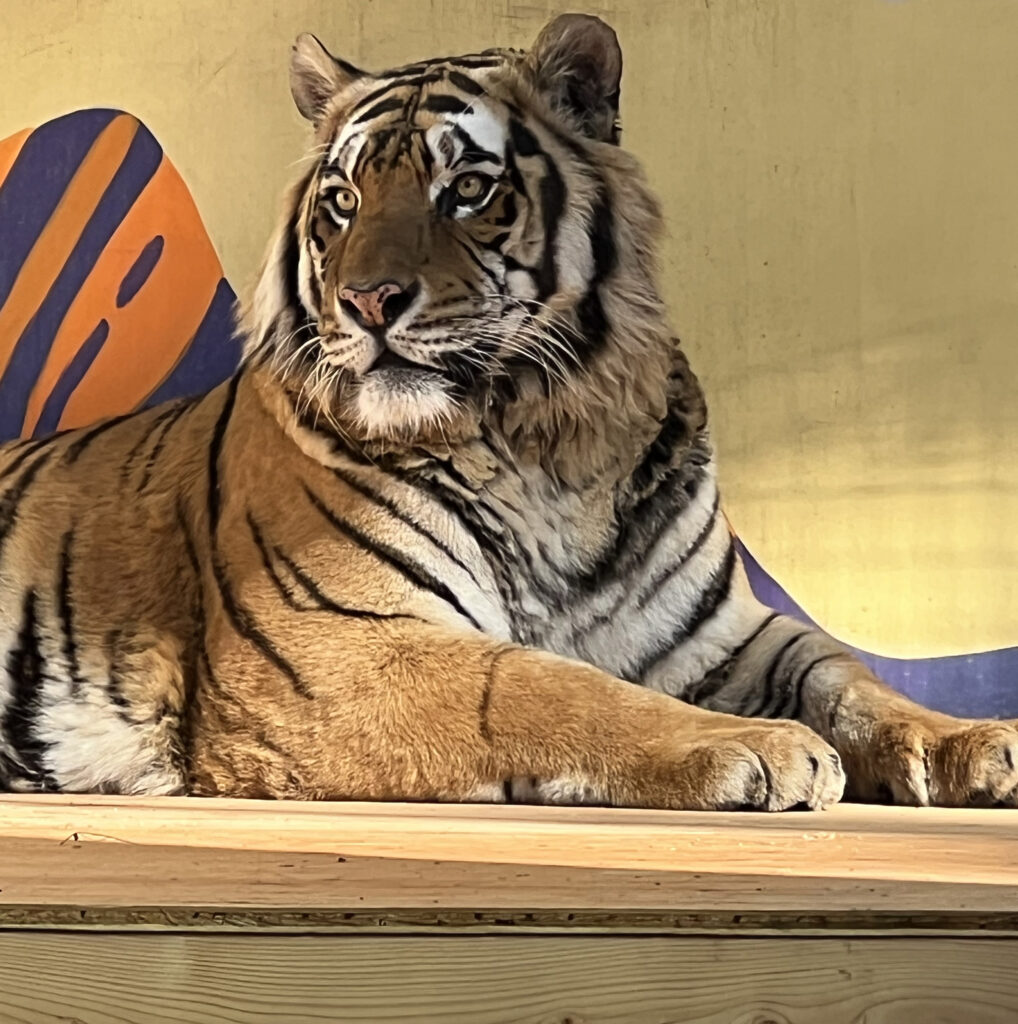Bengal Tigers – Nalin & Tigger
(Panthera tigris tigris)
Majestic. Vocal. Living Legends.
Few animals command the world’s imagination like the Bengal tiger. With eyes like amber fire and a coat of bold black stripes, they embody both power and beauty—symbols of the wild that must be protected. But for many tigers in the United States, life began not in the forests of India, but in cages, roadside exhibits, and traveling shows.
At Cat Tales Wildlife Center, our resident Bengal tigers—Nalin and Tigger—represent a new chapter in that story. Born into captivity through no fault of their own, they now live as ambassadors, teaching visitors about ethics, conservation, and the meaning of true sanctuary.
Tigers in Captivity – From Spectacle to Sanctuary
For decades, captive-born tigers in the U.S. were bred for entertainment and profit. They were used for photos, petting sessions, and traveling exhibits—only to be discarded when they grew too large to handle. The difference between a photo-op prop and a true ambassador animal is immense: one is exploited, the other is respected and cared for.
Thanks to increased awareness and the passage of the Big Cat Public Safety Act, the tide is turning. Public contact with big cats is now prohibited, breeding is restricted, and sanctuaries like Cat Tales continue to advocate for welfare, education, and lifelong care.
Bengal Tiger Fast Facts
- Scientific Name: Panthera tigris tigris
- Habitat: Grasslands, mangroves, and rainforests of India, Bangladesh, and Nepal
- Lifespan: 12–15 years in the wild; up to 20 years in human care
- Diet: Carnivore—large prey such as deer, wild boar, or buffalo
- Conservation Status: Endangered — fewer than 2,500 breeding adults remain worldwide
- Distinguishing Features: Each tiger’s stripe pattern is unique, like a fingerprint. Their roars can be heard up to two miles away.

Meet Our Bengal Tigers
Nalin – The Gentleman Performer
Born August 8, 2008, Nalin spent his early years as part of a traveling performance show at a major U.S. theme park. After the show ended, he needed a permanent home where he could live safely and with dignity. Cat Tales became that home.
Nalin is a striking white (leucistic) Bengal tiger, his pale coat shimmering under sunlight. Despite his regal presence, he’s known for his calm, curious personality and his love of attention. He thrives on enrichment—rolling in hay, batting at barrels, and responding enthusiastically when guests clap or cheer.
Nalin reminds visitors that even the most “domesticated-looking” big cats remain wild at heart. His story also opens conversations about the genetic issues caused by breeding white tigers for appearance, a practice that often compromises animal health for human fascination.
Tigger – The Voice of the Jungle
Born May 20, 2010, Tigger was raised by a private owner who used him for photo sessions when he was a cub—a practice once allowed but now outlawed under the Big Cat Public Safety Act, which protects big cats from exploitation. Like many cubs used for photos, he was no longer wanted once he grew too large to handle. Cat Tales stepped in to give him what every tiger deserves: safety, respect, and space to simply be a tiger.
Today, Tigger is one of our most charismatic and vocal residents. Known for his distinctive “chuff,” he often responds to keepers and guests who chuff first—a tiger’s friendly greeting. He enjoys lounging beside his pool, claiming his favorite shady perch, and occasionally giving visitors a playful surprise with a splash or a territorial spray.
His confidence, curiosity, and willingness to engage make him a favorite among guests and a living example of the power of ethical rescue and sanctuary care.
Conservation & the Future of Tigers
Bengal tigers are Endangered, with fewer than 4,000 individuals left in the wild. Habitat loss, poaching, and human-wildlife conflict continue to threaten their survival. Though tigers in U.S. sanctuaries cannot be released to the wild, they play a vital educational role in connecting people to the cause of global tiger conservation.
At Cat Tales, our mission is to ensure that the tigers in our care live with dignity while inspiring visitors to protect their wild cousins through awareness, advocacy, and compassion.
Life at Cat Tales
Our tigers enjoy spacious, natural habitats designed to engage their instincts and provide comfort throughout the seasons.
Visitors often remark on the contrast between Nalin’s calm grace and Tigger’s bold, chatty presence—two personalities, one powerful species, both serving as ambassadors for tiger welfare.
How Nalin & Tigger Inspire
Education
Through their stories, guests learn about the consequences of breeding big cats for entertainment and the importance of responsible wildlife management.
Advocacy
Nalin and Tigger help amplify awareness of the Big Cat Public Safety Act and the ethical shift toward sanctuary-based care.
Research & Welfare
Daily observation of their enrichment, diet, and health contributes to ongoing efforts to improve welfare standards for big cats in professional care.


